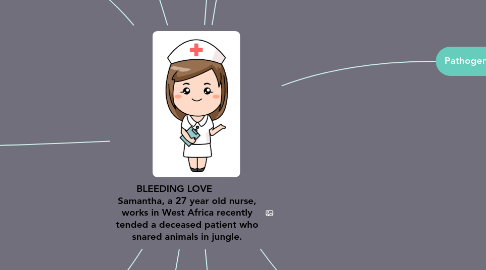
1. Signs & Symptoms
1.1. Early symptoms
1.1.1. Fever
1.1.2. Headache
1.1.3. Lethargic with Sore Throat
1.1.4. Joint & Muscle Pain
1.2. Later symptoms
1.2.1. Vaginal Bleeding
1.2.2. Gastrointestinal Tract Abnormalities
1.2.3. Dry cough
2. Supportive Care Treatment
2.1. Fluid and electrolyte rehydration
2.1.1. Oral
2.1.2. Intravenous
2.2. Blood products
2.2.1. Packed red blood cell
2.2.2. Platelet
2.2.3. Fresh frozen plasma
2.3. Medication / Drug
2.3.1. Antipyretic
2.3.2. Antimicrobial
2.3.3. Analgesic
2.3.4. Antiemetic
2.4. Vaccine
2.4.1. Under trials
3. Prevention & Control
3.1. Proper personal protective equipment (PPE)
3.2. Travel restriction
3.3. Avoid eating bush meat
3.4. Avoid contact with infected people
3.5. Quarantine infected people
3.6. Do not touch infected dead bodies
3.7. Action
3.7.1. Collaboration
3.7.2. Campaign
3.7.3. Media
4. Differential Diagnosis
4.1. Influenza
4.1.1. Airborne transmission
4.1.2. Respiratory tract infection
4.2. Malaria
4.2.1. Mosquitoe-borne
4.2.2. Parasitic protozoa
4.3. Ebola
4.3.1. Zoonotic pathogen
4.3.2. Epidemic in West Africa
4.3.3. Hemorrhage
4.4. Typhoid Fever
4.4.1. Bacterial infection
4.4.2. Spread by eating contaminated food
5. Characteristics of Ebola Virus
5.1. (-) single stranded RNA virus
5.2. Family : Filoviridae
5.3. Genus : Ebolavirus
5.4. Incubation period
5.4.1. 2 to 21 days
6. Epidemiology
6.1. First appeared in 1976
6.2. Cause largest outbreak in year 2014-2015, occurred in West Africa
6.3. Nearly 29000 probable, suspected or laboratory-confirmed cases, with more than 11000 deaths
7. Pathogenesis
7.1. Immune System Evasion
7.1.1. Ab dependent enhancement (ADE)
7.1.1.1. Abs bind to the virus GP spikes
7.1.1.2. C1q binds to Ab-GP complex, enhance them to bind to C1q ligands on the host cell surface
7.1.2. Blockade of IFN pathway
7.1.2.1. VP35 compete with retinoic acid-inducible gene 1 (RIG1) protein
7.1.2.2. VP24 blocks STAT1
7.1.3. Soluble sGP is being encoded
7.1.3.1. Have an anti-inflammatory role
7.1.3.2. Has many similar epitopes with GP
7.2. Connecting the Cellular Mechanism to Hemorrhagic Fever
7.2.1. Attack macrophages & monocytes
7.2.1.1. Release large amount of IL-6, IL-8 & TNF-alpha
7.2.1.1.1. Increase vascular permeability
7.2.1.1.2. Recruit more macrophages to the area
7.2.1.1.3. Hepatocytes are being destroyed, cell signals cannot be cleared from bloodstream
7.2.2. Impaired IFN response
7.2.2.1. Virus VP35
7.2.2.1.1. Bind to dsRNA, further suppressing the RLR-mediated IFN response,
7.2.2.1.2. Interact with PACT, an activator of the IFN-induced antiviral kinase protein kinase R (PKR).
7.2.2.2. Virus VP24
7.2.2.2.1. Bind to karyopherin-α (KPNA) proteins, preventing their interaction with tyrosine-phosphorylated signal transducer & activator of transcription 1 (STAT1)
7.2.3. sGP
7.2.3.1. Limit WBC movement
8. Life cycle
8.1. Virus entry into host cell
8.1.1. Macropinocytosis
8.1.1.1. Outward extension of plasma membrane that can fold back upon themselves
8.2. Virus replication
8.2.1. Virus protein
8.2.1.1. VP30
8.2.1.1.1. Transcription activation factor
8.2.1.2. VP24
8.2.1.2.1. Inhibit virus transcription & replication
8.2.1.2.2. Binds to NP, prevent function of VP35, VP30 or L
8.2.1.2.3. Convert virus transcriptional/replication active form to one that is ready for virion assembly & exit from host cell
8.3. Virus budding and exit from host cell
8.3.1. GP expression
8.3.1.1. Loss of cell to cell contacts
8.3.1.2. Loss of attachment to its substrate
8.3.2. VP40
8.3.2.1. Interacts with human ubiquitin ligase Nedd4
8.3.2.2. Transported to plasma membrane using COPII transport system
8.3.2.3. Virus moves through lipid rafts where the final assembly & budding of the virions occur
9. Lab Diagnosis
9.1. Complete Blood Count (CBC)
9.1.1. Leukopenia
9.1.2. Thrombocytopenia
9.2. Liver Function Test
9.2.1. Aspartate aminotransferase
9.2.2. Alanine aminotransferase
9.3. Coagulation Test
9.3.1. Prothrombin time
9.4. Urinalysis
9.4.1. Creatinine level
9.4.2. BUN
9.5. Virus Isolation
9.5.1. Cell culture
9.6. Serological Test
9.6.1. ELISA
9.6.1.1. Antigen & Antibody detection
9.7. Reverse Transcription-Polymerase Chain Reaction (RT-PCR)
9.7.1. RNA detection
10. Transmission
10.1. Direct contact
10.1.1. Animal to human
10.1.1.1. Bats
10.1.1.2. Wild animals
10.1.2. Human to human
10.1.2.1. Ebola patients (live or dead)
10.1.2.1.1. Blood or bodily fluids
10.1.2.2. Sexual Transmission
10.1.2.2.1. Semen of recovered person
10.2. Indirect contact
10.2.1. Contaminated surface & environment
10.2.1.1. Funerals
10.2.1.2. Syringe & needle

